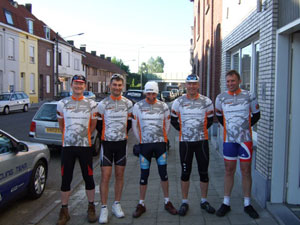 Team Cobblers lines up |
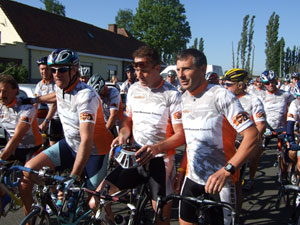 Museeuw (centre) looks lean at the start |
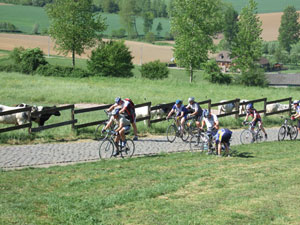 The Paterberg’s cobbled slopes |
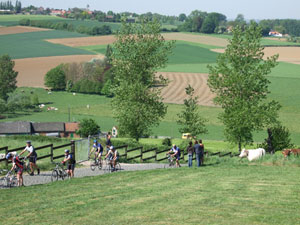 Walking is a sensible choice |
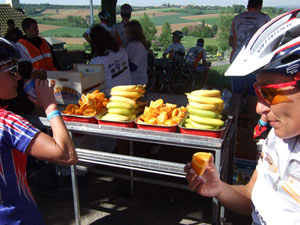 Food… |
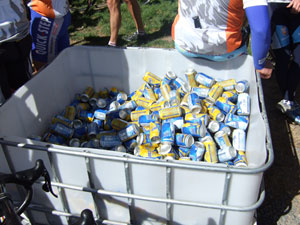 … and drink aplenty |
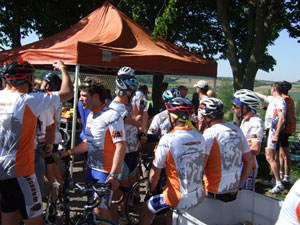 Museeuw group enjoys the sunshine |
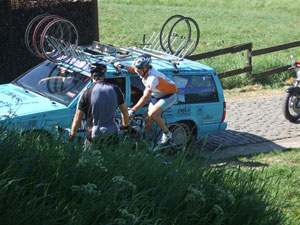 The jeers could be heard on the Kwaremont |
Former classics king Johan Museeuw chose the right day to run the first edition of a cyclosportive bearing his name; not only is the week of the 1st May a public holiday in Belgium, but the weather on 2nd May, the day of the Johan Museeuw Classic itself, was a most un-Belgian mix of unbroken sunshine and, er, cloudless skies.
Team Cobblers, comprising Museeuw bike importer Ken Jones, Eurosport commentator Dave ‘The Harmonator’ Harmon, top tester Paul Mill (Team Edwardes), former multiple national champion Simon Cope and RCUK’s editor assembled outside the White Star football clubhouse in Bellegem, just south of Kortrijk, after a sumptuous breakfast of boiled egg and muesli provided by a very comfortable local bed and breakfast establishment. There we were joined by fellow Brits Callum Gough and Andy Verrall, who work in the successful Belgian composites industry, Gough owning the company that supplies the carbon fibres for Museeuw’s frames and forks.
Thanks to Ken’s close links with the Lion of Flanders, we had been given places in the last group to leave Bellegem at 0945hrs. Around 100 riders, each wearing the ride jersey, set off with Museeuw himself for an ostensibly steady ride to the first feed station at the top of the Paterberg after about 40km. The group then planned to complete a short 80km route; we decided we would follow the longer 135km ride, not least because the weather promised to be just about perfect for bike riding.
The Museeuw Classic, like many Continental sportives, follows a route that acknowledges in some way the racing career of the rider whose name it bears. With three wins in the Ronde van Vlaanderen and a house near Kortrijk, Museeuw naturally chose the hilly terrain south of the Schelde river for the highlights of his event. To get there, it runs through some very pretty countryside, past fields where massive bullocks contentedly chew the cud and the names of the lanes change from Flemish to French and back again with bewildering frequency. The group barrelled through this landscape at a surprisingly quick pace, mainly because many of its members were clearly intent of riding for at least a few hundred metres alongside their hero, and were prepared to do almost anything to get there.
Up near the front of the bunch, Simon and Callum displayed the poise of seasoned Belgian roadmen, never dropping back more than a few places as the bunch constantly threatened to swamp the leaders.
Inevitably, it took a big hill to impose some sort of order, but not before we had sampled the section of pave, or kasseien, known as Trieu Mareserie. As we approached the cobbles, RCUK’s ed. took up station on Museeuw’s wheel through the simple expedient of nerfing a couple of fat Belgians off it. Time for a pave masterclass; for 100m or so, Johan was content to stay on the crown, but soon enough he got bored, dropped off to the right, and with three or four colossal pedal thrusts shot up the side of the line and was gone.
Only as we reached the 1.1km Tarmac climb of the Knokteberg did I see him again at the head of affairs. According to the Harmonator, he had looked a little overweight only a month earlier at the Flanders randonnee; no sign of excess here, although he could probably climb faster than most even with an excess 20kg on board.
By now we were on roads recognisable from the Tour of Flanders, and we dropped down the long main road that runs alongside the Oude Kwaremont at high speed before turning right and tackling the cobbled climb itself. Cyclists of every stripe were out on the hill, taking advantage of the weather and public holiday, but the throng was not dense as it is on the Flanders randonnee. RCUK’s ed. reached the Kwaremontplein hamlet halfway up in the lead, just in time to see a Museeuw jersey’d rider take a left turn. This turned into a fast cobbled descent and then 250m of pave at 18% called the Kalkhoveberg. Another fast descent led to the foot of the Paterberg, which Flanders regulars will know is arguably the nastiest climb in the race. Cobbled all the way for 400m, with a maximum gradient of 20%, the Paterberg is savage even in the dry. No way could I catch the rider ahead; at the steepest point, it was a question of getting off the pave into the gutter or climbing off.
At the top was the first feed, under an awning that kept off any sun that made it through the trees around the cordoned-off area. One of the many cyclists on the climb attempted to get inside to take advantage of the high-piled fruit and bin of sports drinks and was politely rebuffed. So fierce was the pace of the section from the foot of the Kwaremont that members of the Museeuw group were still hauling themselves up the Paterberg as Team Cobblers set off on the long route.
This we rode virtually alone, since the official latest start time for the long ride had been about 0830hrs. Not only did we see no other cyclists, but the countryside and even villages were completely deserted. As Paul observed, entering one such, ‘Have we missed something? It’s as if the Bomb has been dropped.’ Luckily, Andy was familiar with most of the route, which lies in his back yard. For next year the route arrows will be bigger, but they were on the small side and hard to pick out on this first running of the event. Furthermore, they were apparently a hit with Museeuw fans, who had taken some as souvenirs the previous day.
None of this stopped us finding and riding infamous climbs such as the Molenberg, Kluisberg and Koortekeer, which seemed to pop up much more frequently than they do in the Flanders randonnee. We stopped in Oudenaarde for lunch and a coffee, rode many kilometres along the cycle path beside the Schelde, and would have had an unspoilt day had a pillion-carrying motorcyclist not come within an ace of colliding with us as he rode out of a T junction. Luckily for him, he was able to escape before Simon caught him…
By the time we got back to Bellegem, almost everyone had finished. Even so, there was a pile of cheese or ham rolls waiting for us, and decent showers under the grandstand. The ride is run on a start-as-you-like format, and relies on stamped cards rather than transponder timing. This gave it a leisurely, friendly, relaxed feel, which combined beautifully with the perfect weather to make a fantastic day out on the bike. No guarantees on the weather front for next year, but the Museeuw Classic has a route to savour. Anyone thinking of riding the Ronde van Vlaanderen cyclosportive would do well to consider this event instead; it has, after all, a manageable field of around 500 this year, most, if not all of the famous Flanders climbs and, best of all, the possibility of hanging on to Johan’s wheel for at least, oh, 100m.

